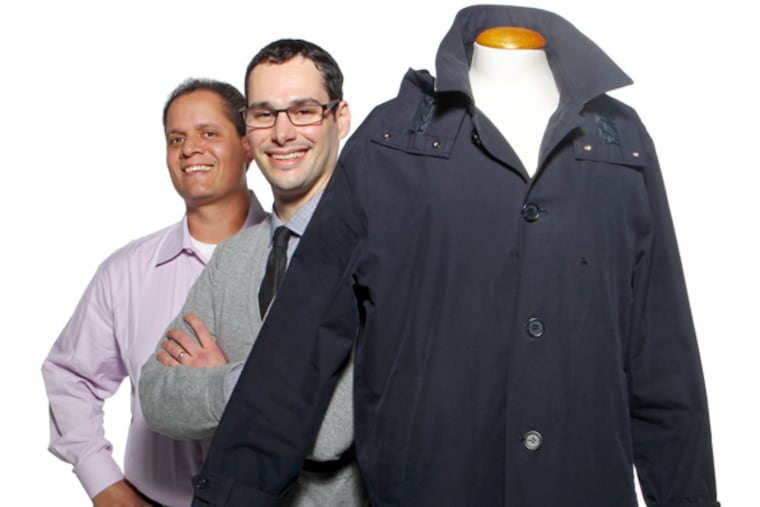Diane Mastrull: Two entrepreneurs see big future for trench coats
Jacob Hurwitz and David Neill are a couple of young Main Line guys who sit around in their free time and, they're not ashamed to admit, talk about trench coats.

Jacob Hurwitz and David Neill are a couple of young Main Line guys who sit around in their free time and, they're not ashamed to admit, talk about trench coats.
That usually happens when they're talking about the U.S. economy.
Think one doesn't have to do with the other? The Wynnewood residents, friends since childhood, are out to show they do with American Trench. It is a company these otherwise employed men - Hurwitz, 33, at an energy firm; Neill, 40, at the family painting business - have developed to help revive the American manufacturing sector.
"We want to make amazing products, we want to create a profitable company, and we want to create employment in this country - those are our goals," Hurwitz said.
Their ambitious voyage set sail soon after Hurwitz's return from a summer 2009 London vacation during which he bought Britain's ubiquitous fashion offering - the trench coat. It was an Aquascutum, a British label since 1851 from the country of rain and fog.
Back in Wynnewood after his trip across the pond, Hurwitz was telling Neill about his coat purchase, which led to economy talk.
"Dave and I were talking about . . . what we thought was wrong," Hurwitz recalled recently. "We felt it had to do with making things." Specifically, the need to get back to making things.
The concept wasn't a stretch for either. Each had spent part of his college years studying art in Italy. Neill majored in fine arts; Hurwitz, math. That eventually led Hurwitz to an analytics job in the energy field, where, he said, one job enabled him "to look at the bones of our economy through electrical load."
After substantial research, he and Neill formed American Trench in February 2010, investing about $50,000 in its start-up so far.
"We chose a trench coat for a very simple reason: We couldn't find one made in America," Hurwitz says in the pair's video on Kickstarter.com, a funding platform through which entrepreneurs raised a reported $274 million in 2012.
American Trench launched its Kickstarter campaign on Dec. 31 with a goal of raising $15,000 by Jan. 30 for cut-and-sew contracting and knitting services and to meet minimum-order factory requirements. Its $725 trench coats are made at a factory in Newark, N.J.
To broaden American Trench's appeal - and provide more manufacturing opportunities domestically - the company, through its website, www.americantrench.com, and the Kickstarter site, is also selling socks, made at a knitting mill in Reading. It is also in product-development talks with Artex Knitting Mill in Westville, Gloucester County, for hats and scarves.
"We want people to know that we are not limiting ourselves," Hurwitz said. "If we can find the makers, we are going to make it."
As of late Friday, they had raised $9,182 through Kickstarter. In all, nine coats had been sold.
"I think they'll probably make it," Don Steinberg, author of The Kickstarter Handbook, said of American Trench's fund-raising goal, noting that it is a modest one.
Unlike products that have gone viral on Kickstarter - frequently technology-related gadgets - American Trench's offering is "not the kind of thing that's an impulse buy," Steinberg said. Consequently, Kickstarter's biggest value to American Trench might just be the attention it generates for its owners' made-in-the-U.S.A. mission, he said.
That's OK by Neill, who insisted: "It's almost criminal that people aren't investing in American companies and products."
He gets an enthusiastic second from Sarah Van Aken, owner of SA VA, a design center, factory, and retail store in Philadelphia specializing in ethically sourced and produced clothing. It was founded in 2009, and its revenues are close to $1 million, Van Aken said.
"I am pro-American-made not just out of patriotism, but because of the local economy, and see a real opportunity for technology-infused apparel manufacturing here in the U.S. to create jobs and dollars in the local and regional economy," Van Aken said in an e-mail. "Too, it makes it easier for folks currently manufacturing if the industry grows, providing more resources."
SA VA made a sample of the American Trench coat for Neill and Hurwitz, and referred them to the Newark factory they now use for full-scale production.
Hurwitz said he and his partner approach fashion from a user perspective. That's why their trench coat has a pocket to store the detachable hood, as well as separate pockets for a cellphone and pens.
The outer shell is 100 percent cotton from a mill in northern Italy. Water repellency is from the tight weave, a design developed during World War II to protect British pilots from the Atlantic Ocean's icy water. The coat's plaid cotton liner is made at a mill in North Carolina.
The coat currently comes beltless, but a belted version is planned.
Reluctant to project revenues, Hurwitz said things would be "great" if sales enabled American Trench to hire five people within a year and have a payroll of 100 or more within five years.
"Hopefully, in the future, we can open our own factory," he said.